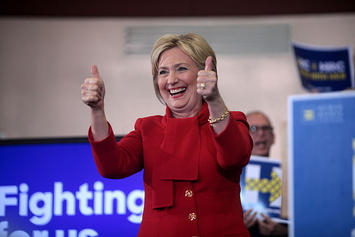
In the latest Quinnipiac poll, Hillary Clinton and Donald Trump are tied in battleground Ohio. This suggests a very close race in Ohio in the fall. Economic issues, especially trade, led many former Democrats to cross party lines to support Trump in the Republican primaries. Many who hadn’t voted in recent elections joined them. We’re likely to see a repeat of this in November unless Democrats change their trade policies. None of this should surprise Democrats, especially those in Ohio.
As a professor of labor studies and co-director of the Center for Working-Class Studies at Youngstown State University for more than 30 years, I had many opportunities to talk politics with workers there. In 2000, many told me that, after voting for Democrats all their lives, they were choosing guns, gays and God over Al Gore, who had been a primary spokesman for the North American Free Trade Agreement (NAFTA) seven years earlier. In 2002, Northeast Ohio Democrats threw out eight-term congressman Tom Sawyer on the basis of his support for NAFTA, despite Sawyer having a 90 percent voting record on labor issues.
Since the passage of NAFTA, Ohio Republicans have controlled state government save for a brief interlude caused by Republican corruption in 2006. At the same time, two Democrats — Sen. Sherrod Brown and Rep. Tim Ryan, who replaced Sawyer — have been elected and re-elected in no small part due to their opposition to NAFTA and the pending Trans-Pacific Partnership (TPP). Clearly, trade policy poses a problem for Democrats and their presumptive candidate. Clinton has been tied to former President Bill Clinton’s NAFTA legislation and its Wall Street proponents. While she has stated that she is against TPP at this time, many Ohioans hear that as weasel words that only contribute to their distrust of Clinton.
It is widely speculated that the Obama administration will push for TPP acceptance in the lame-duck session following the 2016 general election. According to a tweet from CNN’s Dan Merica, Clinton says she will not lobby Congress on the issue. But this will only undermine her credibility and provide Trump with an incentive to continue to demagogue the issue.
In Ohio, about 60 percent of voters in 2012 did not have a college degree, one of the most commonly used (though problematic) proxies for identifying working-class voters. Slightly more than half of them voted for Obama, according to CNN exit polls. But while Obama won a majority of working-class votes in Ohio, he lost among whites, winning only 41 percent of their votes. This suggests that a significant portion of Obama’s working-class support in 2012 came from Ohio voters of color, not white voters. Four years later, the combination of white working-class support for Trump, as we saw in the primary, and expected lower African-American turnout — Clinton is unlikely to inspire the enthusiasm that Obama generated — may swing Ohio’s prized electoral votes to the presumptive Republican nominee.
Clinton needs the support of working-class Ohioans – the very people who have been hurt the most by trade policy. To do that, she needs to stop insisting that trade is good. Her current stance is similar to wooing West Virginia coal miners by touting the benefits of non-carbon fuels. Similarly, she should stop talking about retraining and promising high-tech jobs, which only reminds voters of how hollow such programs have been in the past.
Instead, Clinton should acknowledge that we have lost the trade war and pledge to use every legal means at her disposal to protect American workers and industries from the continued onslaught of imports. This would include initiating trade cases against countries that target American industries by subsidizing their exports, exploiting workers, manipulating their currencies, and polluting the environment.
She should threaten to impose tariffs on every imported product from countries that refuse to implement the same U.S. Occupational Safety and Health Administration and U.S. Environmental Protection Agency regulations and federal, state and local tax requirements that are imposed on American businesses.
At the very least, Clinton should do more than promise to build a strong infrastructure program. Such a program would put the skills, materials and physical strength of working-class Ohioans to work and improve Ohio’s competitive economic environment. Clinton has identified specific programs but she needs to do more to explain how she will pay for them. Otherwise, her campaign platform will sound too much like an echo of past hollow campaign promises.
Clinton should also stress making college affordable for the working class and those living in poverty. Not everyone wants a desk job in front of a computer, and older workers may not be interested in retraining for high-tech jobs. But they do want more education and training for their kids.
Finally, working people worry about how they will fare economically after retirement. They know that Wall Street oversold 401(k) plans and that traditional pensions are disappearing. Clinton needs to reject Wall Street’s calls for changes in Social Security and offer a specific program to maintain private pension plans without cutting benefits.
If Clinton does not develop a strong and believable working-class agenda, I predict that the Democrats will lose Ohio in November, and that would open the door to a Trump victory nationally.
This piece first appeared in the Plain Dealer on June 26,2016, and was re-posted at Working Class Studies blog.
John Russo is a visiting fellow at Kalmanovitz Initiative for Labor and Working Poor at Georgetown University and at the Metropolitan Institute at Virginia Tech. He is the co-author with Sherry Linkon of Steeltown U.S.A.: Work and Memory in Youngstown (8th printing).
Photo by Gage Skidmore from Peoria, AZ, United States of America - Hillary Clinton, CC BY-SA 2.0












